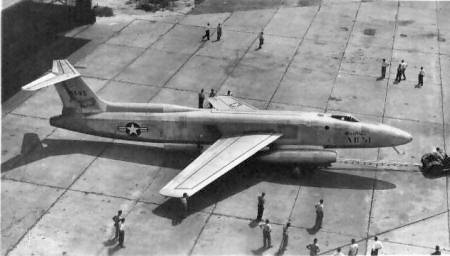06/30/2012. As one of the world's leading aircraft manufacturers, the Glenn L. Martin Company had a 'back-up' plan in case its two-man, three-engined
XB-51 bomber proved to be a failure. But, from its first flight on October 28, 1949 with O.E. 'Pat' Tibbs at the controls, the burly XB-51 seemed incapable of failing. It was revolutionary for its time. Two of its three General Electric J47 engines developing 5,200 lb (2,359 kg) thrust were slung on pylons from the fuselage, and it also incorporated a rotary weapons bay system which permitted bomb delivery at high speed.
And a speedster it was for, being capable of 595 mph (956 kmh) at sea level it could outrun most fighters of the time. It seemed perfect for the USAF's needs and it could have been available for combat in Korea. Even now, there is no clear record as to why the XB-51 attained only 'limited edition' status - kept off the production line for reasons unrelated to its superb performance.
Few experimental aircraft ever underwent such rigorous testing as the XB-51. Two machines were built, serials 46-685 and 46-686, the second flying for the first time on April 17, 1950. They were evaluated against Tactical Air Command requirements for a new generation light-to-medium bomber, but also aroused the interest of Strategic Air Command as well, the first airframe being painted with SAC's distinctive blue band for a time.
The second machine was used in gun, rocket and bomb trials and in successful tests of the rotary bomb-dispensing mechanism. Major Charles E. Yeager once flew five realistic bombing missions in the XB-51 in under three hours while Tibbs, Yeager, Russ Schleeh and other pilots reported that every feature of the XB-51, from its T-tail to its twin-nose 0.787 in (20 mm) cannon, proved easy to operate and effective under simulated combat conditions.
The XB-51 even went to Hollywood, so to speak, serving as the fictitious 'Gilbert XF-120' in the William Holden film 'Toward the Unknown'.
The aircraft combined a radically thin wing with a bulky fuselage propelled virtually by the sheer force of its three power plants. Maintenance people liked it. Pilots loved it.
Why, then, did the XB-51 - which never received a popular name - remain firmly on the side-lines? The reasons are unclear but Walter Boyne, former director of the National Air and Space Museum, believes that there existed an almost irrational USAF prejudice against Martin designs, although not Martin products. Tibbs maintains that thinking was 'too conservative', in an era where most bombers still had propellers. Sadly, neither of the XB-51 airframes survives today.
The unusual bomber, which had been designated XA-45 for a brief period before its July 29, 1949 roll-out from the Baltimore, Maryland factory, had a respectable 990 mls (1,593 km) combat radius with an 18,000 1b (8,165) bomb load. Its service ceiling was 47,800 ft (14,569 m). Some 85 ft 1 in (25.93 m) long, with a span of 52 ft 1 in (15.88 m) and a wing area of 548 sq.ft (50.91 sq.m), the XB-51 grossed 64,154 lb (29,100 kg).
The best evidence of the need for an effective jet bomber in this category was provided when Martin had to exercise its 'back-up' option. When it became dear that the XB-51 would not be ordered in quantity, Martin instead found itself in the unusual position of license-building a foreign design which was less innovative but no less effective. That foreign machine was the B-57 Canberra.
View also this site files photo and photo 5385.
